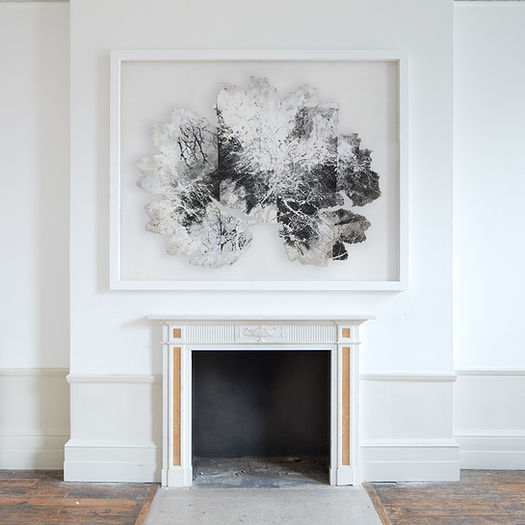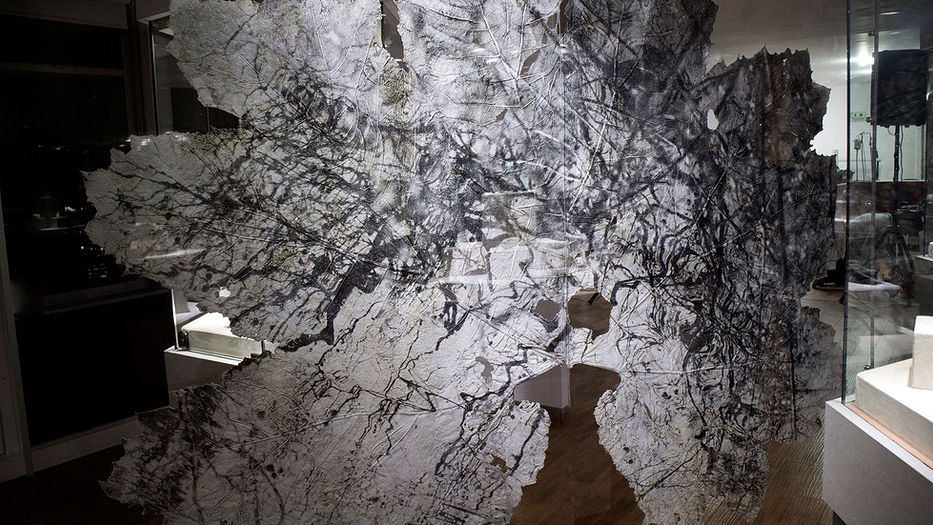
DOMINIQUE LACLOCHE

Dominique Lacloche brings a captivating twist to art by using giant leaves from the ancient Gunnera Manicata plant as her canvas. These leaves, from a plant that dates back to the Jurassic era, are transformed under her skillful hands into stunning photographic art pieces. Lacloche masterfully captures beautiful landscapes and imprints them onto these large leaves, creating a mesmerizing blend of the natural world and artistic imagery. Her work is not just visually striking but also invites us to ponder the intricate relationship between nature and art.
BIOGRAPHY
Dominique Lacloche, an artist with a profound connection to nature, was born in Rome in 1960. She now splits her time between Paris and London. Over the past two decades, Lacloche has distinguished herself with her unique art form, utilizing the Gunnera Manicata, a plant from the Jurassic era, as her medium. This distinctive approach, where she develops photographic images directly onto the leaves, has garnered international acclaim.
Her artistic journey is marked by an exploratory and empirical methodology. Lacloche's work transcends traditional boundaries, blending photography, sculpture, and immersive installations. This innovative approach has led to the creation of the "image-leaf," a concept where the leaf's natural texture and form become integral to the photographic image, resulting in a compelling "Mise en Abyme" effect. This technique showcases not only Lacloche's artistic prowess but also her deep respect and understanding of the natural world.
In addition to her work with the Gunnera Manicata, Lacloche's interests span across various temporal systems and organic processes. She has ventured into the realms of film, digital animation, sound design, and electroacoustic music composition, demonstrating her versatility and commitment to exploring different facets of artistic expression.
Her remarkable works, such as "Leaf V" (2020), are not just artistic creations but also represent a journey through time and evolution. Lacloche revisits specific landscapes, capturing their transformation over the years. The images she develops on the Gunnera leaves evolve from distinct landscapes to abstract forms, reflecting her deepening connection with her subject matter.
Lacloche's art is a delicate balance between control and surrender to the unpredictable forces of nature. Each piece is a testament to her ability to navigate and harmonize the technical and organic elements of her work. The result is a series of artworks that are not only visually striking but also intellectually stimulating, inviting viewers to explore the complex relationship between art, nature, and time.
Dominique Lacloche's artistry, thus, stands as a powerful narrative of renewal and the perpetual cycle of creation and destruction. Through her work, she captures the essence of nature and art coexisting in a state of harmonious balance, offering a unique and profound perspective on the world we inhabit.
GUNNERA LEAVES
The images revealed on the leaves are most often of landscapes reflected in the water. At our scale, these landscapes are encompassing and poetic, absorbing us in the reflection; yet due to the salience of the work’s spatial disposition and the material on which the images are printed, the images become fleeting landscapes of emotions. Like apparitions hovering between the infinitely elusive and the infinitely intimate, what is communicated through the veins of the leaves, faintly or clearly, is akin to visions of “another world” strangely familiar to us.
The visual operation at work here, which is played out just as much in Lacloche’s technical balancing of elements, as it is in the unpredictable and uncompromising intricate technicalities of the work’s natural element, is imbued with something of the unspeakable recommencement of things. Each “leaf image” leads to another, and then another, like the unfolding of multiple ways of showing the world as a creative source. The ‘here and now’ uncoils – renewed, regenerated, or in a state of inexorable destruction –the slow and imposing march of a state of nature and a “state of the art”, reconciled.
Text by Sandra Vanbremeersch
Dominique Lacloche prints silver gelatin photographic images onto giant Gunnera Manicata leaves. The leaves of this 40-year-old South American plant are distinctive for their disproportionate size, measuring up to 2 or 3 meters across. Handling the plant is extremely precarious: the monumental apace with the fragility of living matter.
It is through the light that this unique plant and photographic technique converge –the unpredictable nature of organic life and of chemical “life” plays out through both photosynthesis and photographic revelation. The image passes through anarchic, delicate, unpredictable phases, and the artistic gesture yields to the force of external events that impose themselves like“natural” laws.
The disproportionate size of the leaves, which can be used as the simple material support for an image, as part of an installation, as a pretext for other manipulations of images (superimpositions, work on the photographic negative, etc.), may prevail over the “image subject” at any given moment and transport vision to a world where the monumental dictates its own laws. The spatial arrangement and intelligibility of these giant leaves is thus a test of strength for the artist, an endeavor to strike the right balance.














































